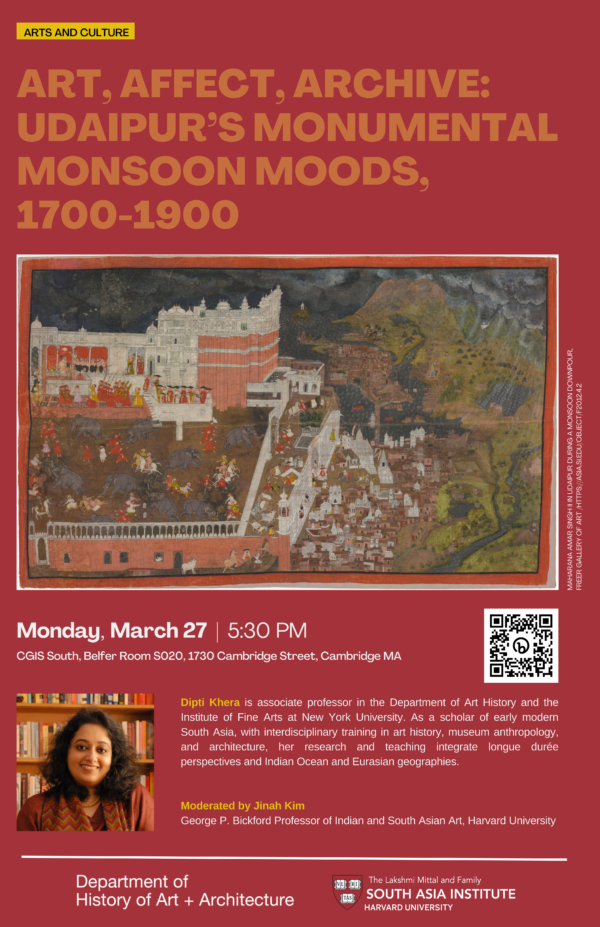Udaipur’s eighteenth-century painters, more so than their earlier counterparts, exponentially stretched the affective potential of pictorial moods. They circulated images and ideas about flourishing places beyond and between objects commissioned within courts and bazaars. In the wake of British colonial ambitions, their pictures suggest counterfactual realities within moods of plenty that work against narratives of scarcity and inadequacy. Raising questions on the methods of sensing and making sense of monumental monsoon moods, this talk discusses how we construct our archives, circumscribe artworks and architecture; how claims of territoriality and infrastructure surface in art and vice versa; and how we tell histories of the entanglement of emotions, ecology, and place in South Asia and beyond.
Bio: Dipti Khera is associate professor in the Department of Art History and the Institute of Fine Arts at New York University. As a scholar of early modern South Asia, with interdisciplinary training in art history, museum anthropology, and architecture, her research and teaching integrate longue durée perspectives and Indian Ocean and Eurasian geographies. Along with specializing in paintings, books, letters, and maps made in northern and western India, she has published on the crafting of colonial taste and foregrounded vernacular objects that reveal global art history’s blind spots in narrating stories of mobility, power, and emotional entanglements. A co-edited volume for Journal18 (December 2021), “The ‘Long’ Eighteenth-Century?” considers from which vantage points, whether local, regional, or transregional, is the eighteenth century long, and to what ends we deploy such visual and material microhistories. Her book The Place of Many Moods: Udaipur’s Painted Lands and India’s Eighteenth Century (Princeton University Press, 2020) received the Edward Cameron Dimock, Jr. Prize in Indian Humanities (American Institute of Indian Studies), and was shortlisted for the Charles Rufus Morey Book Award (College Art Association), BASAS Book Prize (British Association for South Asian Studies), and Kenshur Prize (Center for Eighteenth-Century Studies). A recent co-edited catalogue, A Splendid Land: Paintings from Royal Udaipur (Hirmer Publications, distributed by University of Chicago Press, 2022) accompanies the co-curated exhibition currently on view at the Smithsonian’s National Museum of Asian Art, Washington DC.
Image caption: Maharana Amar Singh II in Udaipur during a Monsoon Downpour, c. 1705, Udaipur. Opaque watercolor and gold on cloth, 109.2 × 175.2 cm. Freer Gallery of Art, Smithsonian Institution, Washington, DC; purchase and partial gift made in 2012 from the Catherine and Ralph Benkaim Collection, Charles Lang Freer Endowment, F2012.4.2.

